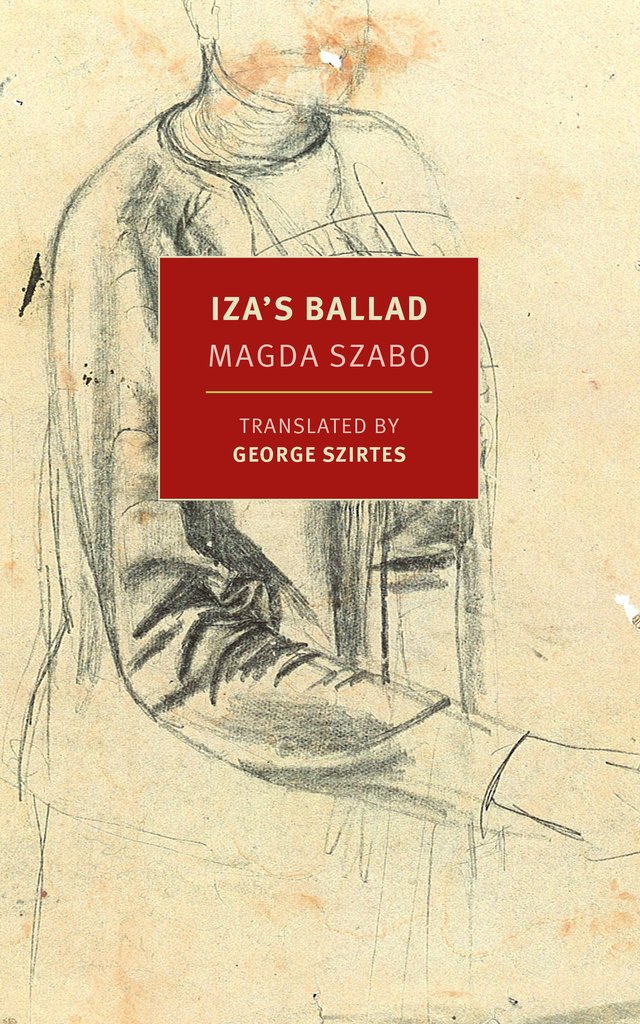Iza’s Ballad
by Magda Szabó, translated by George Szirtes
reviewed by Ophelia John
Magda Szabó (1917-2007) published novels, works for children, verse, drama, and essays in her native Hungarian over a career that included publication in forty-two countries and the Prix Femina Étranger (2003). In 1949, Szabó received one of Hungary’s highest literary honors, the Baumgarten prize, only to have it withdrawn that same day as she was declared an enemy of the new Communist state. Her books would be blocked from publication for the next seven years.
Of Szabó’s many works, two have come to the recent attention of readers in the United States. The first, Len Rix’s 2005 retranslation of The Door (1987), reached the US in 2015. An incandescent portrait of a fierce old woman named Emerence who manages the narrator’s household, the book’s title refers to the always-locked door of Emerence’s own home, behind which are hidden physical memories of Hungary’s WWII years and the brutal Stalinist period (1949-1956). Although The Door depends, to an extent, upon a grasp of midcentury Hungarian history, the exquisite self-interrogations of the narrator lead the reader straight into the emotional gut-punch of the ending. The much earlier Iza’s Ballad (1963; English translation 2016 by George Szirtes) shares many elements with The Door, including the alienating quality of modern urban life, the casting of older people as emotional and tied to the past, a “selfish” professional woman, and an unacknowledged secret. Divided into four sections, the point of view largely moves between Iza, her mother Ettie (usually called “the old woman”), and her ex-husband Antal, but also dips distractingly into the perspectives of several minor characters.
Following the death of her father Vince, lovely, competent Iza takes charge of her mother’s life, moving her out of the village and into a room in Iza’s own apartment in Budapest. The focus then moves to Antal, a kind man who is still fond of his former in-laws. Like Iza, he is a physician; unlike her, he still works at the village hospital. When the time frame shifts to Antal’s childhood, we learn that he is the child of a laborer who died in a brutal work accident, upon which the boy received a scholarship to attend primary school—and book money from Iza’s father, a left-leaning judge who was forcibly retired during the right-wing 1920s. Antal learns of his benefactor’s political disgrace in 1933, meets and falls in love with Iza in 1941, and marries her in 1948.
The story math, while slight, helps to situate the reader and portray the characters as political, rather than personal, entities. This, however, is also where the novel falters a bit in translation; presumably a Hungarian reader would instantly grasp the specific meaning of these dates, but an English-language reader has little context within the novel. In particular, the title is a missed opportunity. Originally Pilátus, or (Pontius) Pilate, the Hungarian title is a clarification of Iza’s essentially political nature—she absorbed her father’s defeats as a child and therefore conducts her life as a soldier for the cause. But it is not until the end of the novel, after many pages of a growing uneasy feeling, that the central conceit becomes clear. Why has Iza uprooted her elderly, peasant-like mother from the village and all that she knows, why does she leave her alone and friendless in a city apartment full of appliances that she is afraid to operate? That the old woman suffers from this transplantation, and ultimately will die of it, is clear to the reader; that Iza deliberately harms her mother is less certain. Rather, like Pilate, she carries out her duty while remaining blind to the ultimate result of her actions. In the chilling final pages, the scales fall from the eyes of Iza’s new boyfriend, Domokos, and he, like Antal before him, realizes that he must leave her or die. Iza is left free of all relationships, restless, utterly modern, with all the time in the world to focus on her work—just as she once chose to focus on revolutionary politics to the detriment of her first love. Yet even after both men’s epiphanies are detailed, Iza—in contrast to the other characters—remains unknowable.
With the benefit of a half-century of distance, Iza’s Ballad can also be read as practice for the masterfully crafted, thematically similar The Door. A passage from the middle, when Antal was still a “thickset fourteen-year-old peasant boy,” best illustrates the earlier novel’s style and scope:
As soon as he was outside the door Antal said something truly terrible about Mr Bérczes [Antal’s father’s employer], the kind of thing his father was screaming on his deathbed, then leaned against the iron railings that ran alongside the wooden steps in exactly the same way as they had done a good century and a half ago when the school was first rebuilt after the fire, and kissed it as though it were a living creature with a mouth.
Szabó plumbs every detail to create a slow-burning political and architectural portrait of rural Hungary, and then surprises with a character’s startling, vivid gesture. While the time and place of Iza’s Ballad have since vanished, its essential human questions have not.
Published on October 16, 2017

